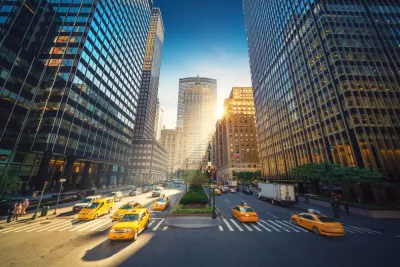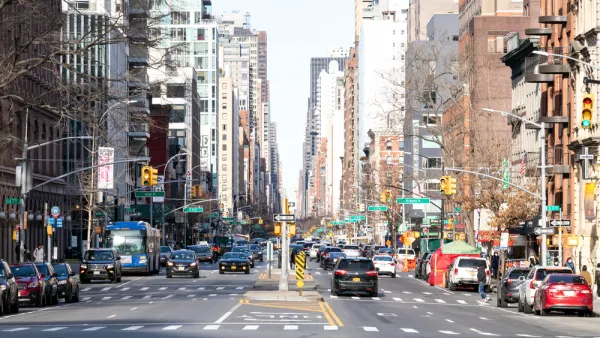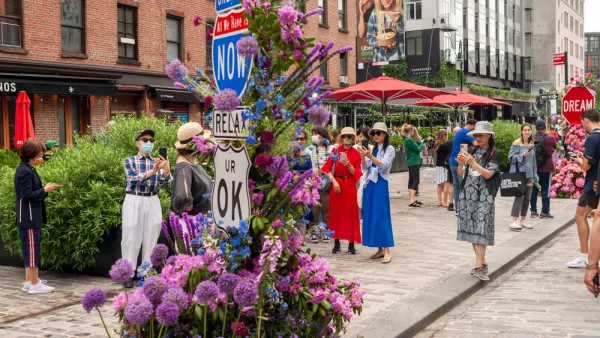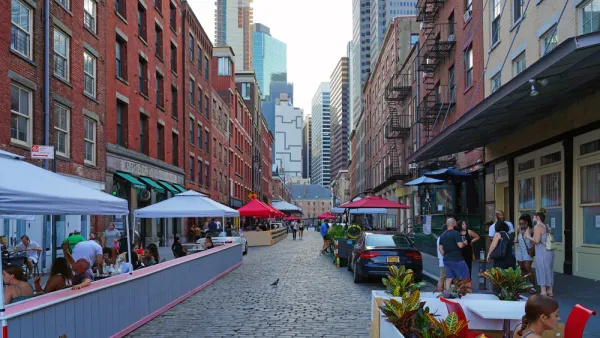The debate about whether the pedestrian-oriented changes made to the New York City streetscape during the pandemic should be permanent has a high-profile battleground on Park Avenue.

John Surico writes about a planning opportunity that could restore the median of Park Avenue in Manhattan to its former prominence as a pedestrian promenade.
"It has been a long time, but once it was possible and even fashionable to take a stroll through a far different Park Avenue, one with a green swath of lush lawn and shrubbery nearly 40 feet wide. It was the city’s first linear park, where pedestrians took precedence over cars and there were plenty of benches to take a break," according to Surico.
A project to repair an underground, "cavernous" shed used by Metro-North commuter trains traveling in and out of Grand Central Station also offers an opportunity to "transform Park Avenue’s malls and restore them to their original splendor," reports Surico.
"The work requires ripping up nearly a dozen streets along Park Avenue, from East 46th to East 57th Streets, making possible a new vision for that stretch of the thoroughfare."
"Among the options the city is considering is bringing back chairs and benches, along with more ambitious ideas like expanding the median, eliminating traffic lanes and carving out room for bike lanes and walking paths."
The Park Avenue project is just one example of an ongoing, citywide debate about whether the pandemic offered a chance to permanently rethink the city's streets, providing more space for pedestrians and people on bikes instead of more and more cars. As with other examples around the city, "the removal of traffic lanes along Park Avenue is likely to elicit backlash from drivers who complain that the addition of pedestrian plazas and bike lanes across the city has made it increasingly difficult to get around," writes Surico. The city has already retreated from some of the open streets and bus priority plans crafted during the pandemic.
FULL STORY: New York City Wants to Bring More Park to Park Avenue

National Parks Layoffs Will Cause Communities to Lose Billions
Thousands of essential park workers were laid off this week, just before the busy spring break season.

Retro-silient?: America’s First “Eco-burb,” The Woodlands Turns 50
A master-planned community north of Houston offers lessons on green infrastructure and resilient design, but falls short of its founder’s lofty affordability and walkability goals.

Delivering for America Plan Will Downgrade Mail Service in at Least 49.5 Percent of Zip Codes
Republican and Democrat lawmakers criticize the plan for its disproportionate negative impact on rural communities.

Test News Post 1
This is a summary

Test News Headline 46
Test for the image on the front page.

Balancing Bombs and Butterflies: How the National Guard Protects a Rare Species
The National Guard at Fort Indiantown Gap uses GIS technology and land management strategies to balance military training with conservation efforts, ensuring the survival of the rare eastern regal fritillary butterfly.
Urban Design for Planners 1: Software Tools
This six-course series explores essential urban design concepts using open source software and equips planners with the tools they need to participate fully in the urban design process.
Planning for Universal Design
Learn the tools for implementing Universal Design in planning regulations.
EMC Planning Group, Inc.
Planetizen
Planetizen
Mpact (formerly Rail~Volution)
Great Falls Development Authority, Inc.
HUDs Office of Policy Development and Research
NYU Wagner Graduate School of Public Service





























